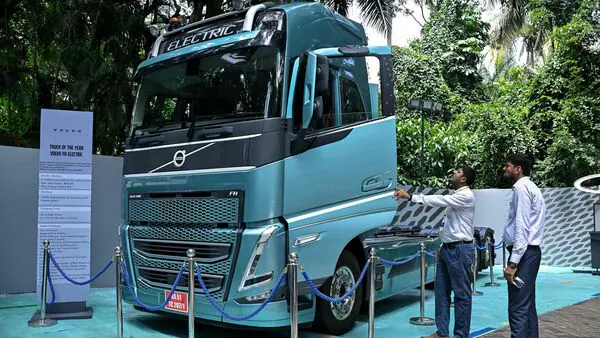
India's Ambitious Localization Plan For E-Truck Makers Faces A Scalability Block
A chicken-or-egg-first problem has developed in the country's electric truck industry with the government pushing manufacturers to comply with an ambitious localisation plan, while e-truck makers demur on indigenisation given concerns over tepid demand.
Two people aware of recent consultations between the Union heavy industries ministry and e-truck makers such as Tata Motors , Ashok Leyland, Volvo Eicher Commercial Vehicles, and Murugappa-group's IPLTech, among others, said that the government had asked the manufacturers to comply with the localisation criteria in consultations earlier in October.
A phased manufacturing programme (PMP) for e-trucks unveiled in July as part of the ₹10,900-crore PM E-Drive scheme set deadlines for components that e-truck makers would be allowed to import. Most such products and components are imported from China currently.
It listed products and components such as an HVAC system (heating, ventilation, and air conditioning), electric compressors for brakes, charging inlets for standard EV chargers, a battery management system, a vehicle control unit, and traction motors, among others. The cutoff date for the import of most of these components was 1 September 2025, with imports of a few being allowed till 1 March 2026.
One recent relaxation was when the government allowed e-truck makers to import traction motors with rare earth magnets from Chinese suppliers in the wake of the rare earth magnet supply cut from China.
The PM E-Drive scheme for e-trucks and e-buses has been extended by two years till FY28 in August this year, only a few months before it was set to lapse as funds for these two vehicle segments had not been utilised.
The ₹10,900 crore support in the scheme is earmarked for subsidies on purchase of electric two-wheelers, three-wheelers, e-buses, e-trucks, electric and hybrid ambulances, and charging infrastructure. E-buses made up about 40% of the allocation.
Testing delaysMeanwhile, even after more than two months since the guidelines for e-trucks were announced, no e-truck model has passed the localisation test as of date, said one of the persons above, requesting anonymity. This indicates the shift to localisation is slow.
“The government has asked e-truck makers to expedite the testing process," said the first person cited above. The testing will show what local parts are used in e-trucks and e-buses.
This is despite Indian auto components makers beginning to make critical parts locally. Companies such as Sona Comstar (listed on the exchanges as Sona BLW Precision Forgings Ltd) are making traction motors and Toyota Kirloskar Auto Parts Ltd is planning to make trans-axles for EVs indigenously. These two products, as also a few others, are included in the government's ₹25,938-crore production-linked incentive scheme for automobiles and auto parts, where localisation criteria call for 50% of spare parts and raw materials to be sourced in India.
E-truck makers cite uncertainty in demand for the slow switchover to local components while the government has countered that companies using trucks in sectors such as ports, steel, and cement have shown intent to transition to green logistics, according to the second person mentioned above, who also requested anonymity.
Also Read | Electric truck buyers skip PM E-Drive scheme as scrappage papers elud
Email queries sent to the heavy industries ministry, as well as truck makers Tata Motors, Ashok Leyland, IPLTech, and Volvo Eicher Commercial Vehicle remained unanswered.
Shifting to e-trucks is expensive for businesses as these are 20% to 50% pricier than diesel models, according to domain experts. The growth in sales of so-called N2 and N3 e-trucks is at a healthy 27.5% between fiscal 2025 and the previous fiscal year but the underlying numbers are very small: 301 e-trucks were sold in India in fiscal 2025, less than 0.1% of the number of diesel trucks sold in the year. (N2 trucks have gross vehicle weight of 3.5 to 12 tonnes and the bigger N3 variants range from 12 to 55 tonnes.)
Indigenising e-truck making for local manufacturers becomes viable only with a bigger demand, an expert said. E-truck makers have a complex effort ahead of them in“vendor management not only at Tier 1 but also Tier 2 and Tier 3 levels," said Sharif Qamar, associate director for transport and urban governance at The Energy and Resources Institute. "Unless they have the necessary scale and demand for their products, using expensive local components can impact their margins."
Also Read | E-truck sales pick up after PM E-DRIVE incentives, private financing scheme
Legal Disclaimer:
MENAFN provides the
information “as is” without warranty of any kind. We do not accept
any responsibility or liability for the accuracy, content, images,
videos, licenses, completeness, legality, or reliability of the information
contained in this article. If you have any complaints or copyright
issues related to this article, kindly contact the provider above.
Most popular stories
Market Research

- Pepeto Highlights $6.8M Presale Amid Ethereum's Price Moves And Opportunities
- Codego Launches Whitelabel Devices Bringing Tokens Into Daily Life
- Zeni.Ai Launches First AI-Powered Rewards Business Debit Card
- LYS Labs Moves Beyond Data And Aims To Become The Operating System For Automated Global Finance
- Whale.Io Launches Battlepass Season 3, Featuring $77,000 In Crypto Casino Rewards
- Ceffu Secures Full VASP Operating License From Dubai's VARA



















Comments
No comment